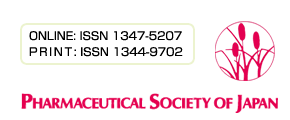| |
Software Requirements
Microsoft Internet Explorer 5.01 or higher and Netscape Navigator 4.75 or higher are recommended. |
|
 |
J.Health Sci., 50(4), 372-378, 2004
Effects of Iron Overload on Hepatic and Renal Metallothionein Levels in Rats
Akira Yasutake*, a and Kimiko Hirayamab
aBiochemistry Section, National Institute for Minamata Disease, 4058-18 Hama, Minamata, Kumamoto 867-0008, Japan and bKumamoto University, College of Medical Science, 2-24-1 Kuhonji, Kumamoto 862-0976, Japan
Metallothionein (MT) is one of the stress proteins induced by various heavy metals and oxidative stress. Although induction by Fe has not been well established, its overload is documented to cause oxidative stress in experimental animals. To investigate alteration in tissue MT levels that were possibly caused by Fe overload, male Wistar rats were fed a diet containing 3.5% Fe(II) fumarate (1.2% as Fe) for up to 21 days. Tissue Fe levels in liver and kidney increased in time-dependent manners up to 7.2 and 2-fold, respectively, by the end of the experiment. Interestingly, plasma Fe levels showed a maximum on day 3, then decreased to the control level. The hepatic MT levels showed a transient decrease on day 3, then turned to increase throughout the experiment period, with the final level higher than that in control animals that fed on a normal diet. MT levels in the kidney decreased to nearly 1/3 of the control on day 3, with the values unchanged thereafter. Although Zn levels in liver, plasma and kidney showed a transient but significant reduction on day 3 of the Fe feeding, they recovered to the control values in the later period. Thus, a time-dependent change in the hepatic MT levels was quite similar to that of the tissue Zn levels. The renal Zn levels could not account for the change in the tissue MT levels, at least in the latter period of the experiment. Hybridization analysis of the MT mRNA in the kidney of Fe-fed rats did not differ from control-diet rats, suggesting Fe feeding would not alter synthetic rates of the renal MT. The turnover rates of the renal MT estimated from a time-dependent alteration after its induction by HgCl2 treatment seemed to be enhanced in Fe-fed rats. Thus, the Fe-induced decrease in the renal MT level could possibly be due to an enhanced turnover rate. Despite the reduced renal MT levels, the Fe-treated rats showed no sign of a renal failure indicated by a stable plasma creatinine levels and sustained increase of body weight, suggesting that the Fe-induced suppression of the renal MT levels would not be one of the toxic effects by this metal. Nevertheless, the HgCl2 injection experiment revealed Fe-fed rats had a slightly higher susceptibility against HgCl2 nephrotoxicity than the control-diet rats.
|
|

